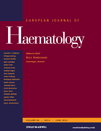Significant change in ZAP-70 expression during the course of chronic lymphocytic leukemia
Abstract
Introduction: It is widely accepted that expression of ZAP-70 in chronic lymphocytic leukemia (CLL) remains stable in time. However, data supporting this notion are surprisingly scarce. Therefore, we assessed expression of ZAP-70 in serial samples taken during the course of the disease.
Patients and Methods: We studied 44 patients with CLL diagnosed according to NCI-WG criteria (34 men, 10 women, median age 62, range, 36–81). A total of 104 samples were examined; all patients had at least two measurements. Median interval between the first and the second sample was 13 months (range, 2–36). ZAP-70 expression was detected by flow cytometry using phycoerythrin-conjugated monoclonal antibody clone 1E7.2 and negative isotype control. Twenty percent of positive cells were considered as the threshold of positivity.
Results: Significant change in ZAP-70 expression (i.e. from positivity to negativity and vice versa) was detected in 15/44 patients (34%). Interestingly, 7/8 patients whose ZAP-70 expression converted to positivity had unmutated IgVH genes. In addition, the conversion was accompanied by clinical progression or relapse in all but one patient. On the other hand, 5/7 patients with loss of ZAP-70 had stable clinical course. One patient became ZAP-70-negative during treatment with prednisone for autoimmune hemolytic anemia.
Conclusions: In contrast to commonly accepted opinion, significant change in ZAP-70 expression in time was detected in a substantial proportion of our patients with CLL. While the conversion to ZAP-70 negativity was found predominantly in patients with stable disease, change to positivity was typical in patients with unmutated IgVH genes at the time of progression or relapse. Based on our pilot results, repeated assessment of ZAP-70 expression might be especially useful at the time of progression or relapse in patients who were initially ZAP-70-negative.




